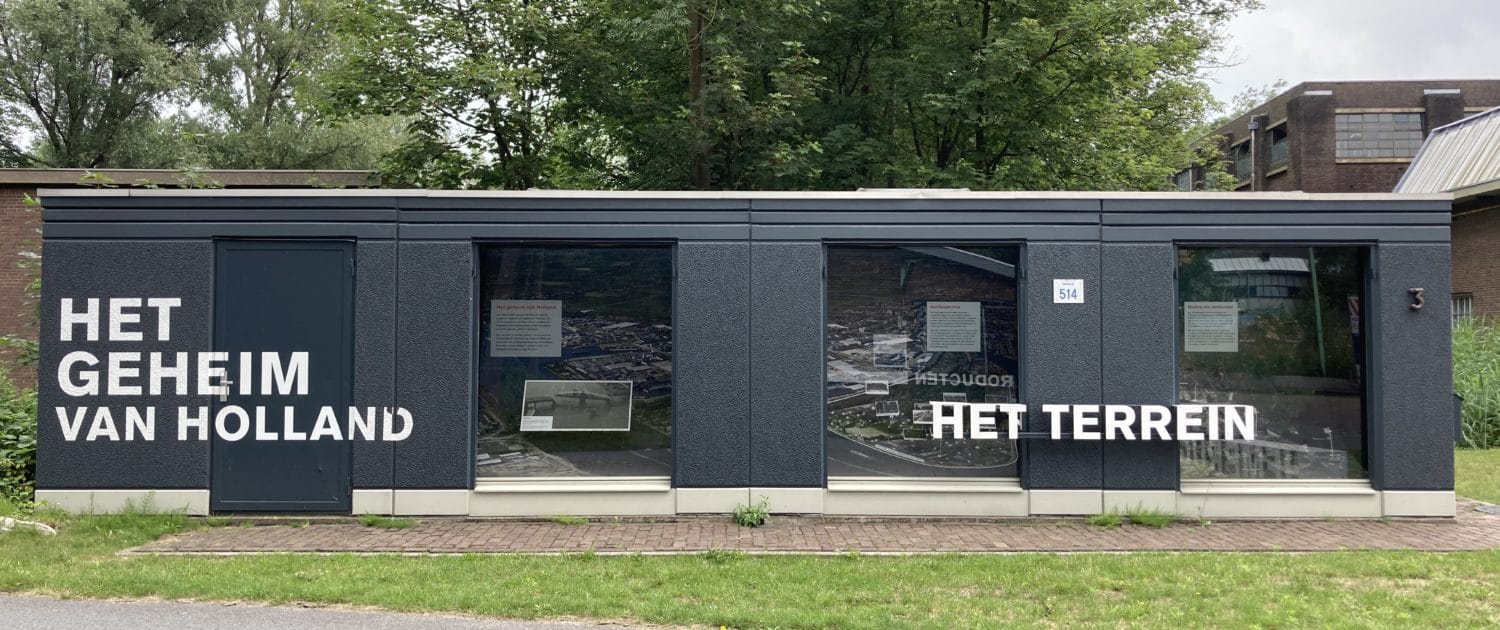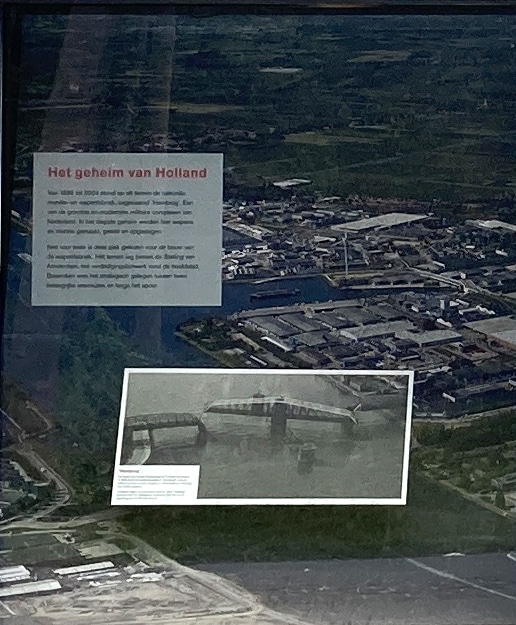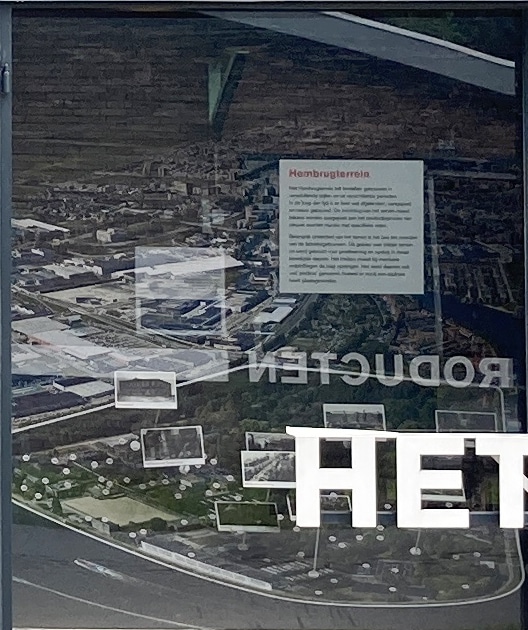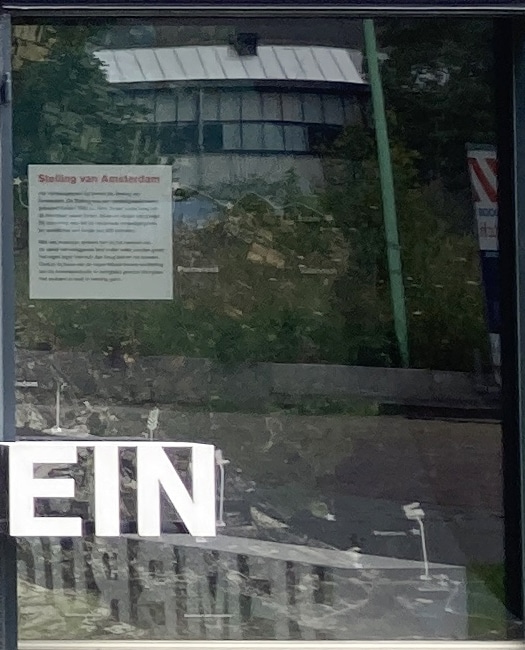Scroll down or click on a number in the image and read the English translation. Click on the arrow at the bottom right of the screen to go back up to the overview photo.
-1-
1 – The Netherlands’ secret
Between 1895 and 2003, this is the site of the national ammunitions and arms factory, nicknamed ‘Hembrug’. It is one of the Netherlands’ biggest, most modern military complexes. Weapons and ammunition are made, tested, and stored here in the utmost secrecy.
There’s a reason this place was chosen to build an arms factory: the site is within the Defence Line of Amsterdam (Stelling van Amsterdam), the fortification around the capital city. Moreover, it was strategically located between two major shipping routes and next to the railway.
2 – ‘Hembrug’
The factory’s official name is ‘Staatsbedrijf der Artillerie Inrichtingen’. In 1973, the company is split into ‘Eurometaal’, where military production continues, and ‘Machinefabriek Hembrug,’ which makes civilian products.
Before long, the factory becomes popularly known as ‘Hembrug,’ after the nearby neighbourhood of Den Hem and the railway bridge spanning the North Sea Canal.
-2-
1- Hembrug site
The Hembrug site has dozens of buildings of varying styles and from different periods. Much has been dismantled, altered and rebuilt over the years. On numerous occasions, buildings on the site had to be adapted to accommodate production processes for new types of ammunition with specific requirements.
The woods to the north of the factory buildings are a key feature of the site, military terrain that was used for testing and for storage in heavily guarded depots. Woodland deadens the bangs of any explosions, hence the moniker ‘plofbos’ (blast forest) – although there never were any explosions here.
2- Zones
The site is split into three zones. Along the waterfront are the mundane buildings: offices, laboratories, homes and canteens. Behind those are the large factory buildings and workshops turning out weapons, shells, ammunition, machines, and civilian products. Some of these buildings have air-raid shelters. The woods on the northern side conceal the buildings for testing and storage (munitions stores). After the Second World War, this area is requisitioned by the Ministry of Defence, which takes over munitions testing from Artillerie Inrichtingen.
Buildings
The factory buildings are numbered, with functional names: the press shop, the furnace, the forge, the washroom etc. Various parts of the factory are given nicknames such as De Dood (after the manager’s surname), the Grote Boerderij (Big Farm), the Kleine Boerderij (Little Farm) and the Kathedraal (Cathedral, because of its architectural style).
Woods
The woods to the north of the factory site date back to around 1920 and are the oldest ‘man-made’ woods in the Netherlands. Officially, the woods are known as the R.A.V.O.S. woods (Reglement Aanvullende Voorschriften Ontplofbare Stoffen, Regulations on additional requirements for explosive substances), but their nickname is plofbos (blast forest).
Growing on peatland, the woods are rich in rare vegetation and provide a habitat for a variety of animal species including buzzards, owls, wild hares, striped salamanders, and foxes. Until recently, they were also home to the Netherlands’ largest colony of herons.
-3-
1 – Stelling van Amsterdam
Hembrug sits within the Defence Line of Amsterdam. The Stelling van Amsterdam is a fortification built between 1880 and 1914 and forms a large ring of forts, dikes, and sluices around the capital. At the time of its completion, the 135 kilometre-long Stelling is the modest modern defence line in the world.
Using an ingenious system, when the enemy approached, the surrounding land could be flooded and the defending army would retreat into the stronghold. The arms factory’s location within the Stelling meant that ammunition production could continue uninterrupted during the war. The defence line has never been called into action.
2 -The fortifications
The Stelling boasts all the facilities needed to survive a siege, such as grain storage, drinking water, a military hospital, a clothing store, a gunpowder factory, and the ammunitions and arms factory. Hembrug also provides storage for munitions and supplies for the forts.
The Hembrug site is also home to the General Defence Park – a storage and testing location for weapons and munitions for the whole Defence Line – and the Sectorpark Zaandam, which supplied equipment and munitions to the surrounding area.
Modern technology has rendered the line obsolete: aircraft simply fly over the defences.
The uniqueness and special history of the Defence Line of Amsterdam have earned it UNESCO World Heritage status.















